
The Ōsumi class (おおすみ型輸送艦), is a Japanese tank landing ship. The class is also known as the Oosumi class. While the Japan Maritime Self-Defense Force (JMSDF) describes the Ōsumi class as tank landing ships (LSTs), they lack the bow doors and beaching capability traditionally associated with LSTs. Functionally, their well deck makes the Ōsumi class more like a dock landing ship (LSD).
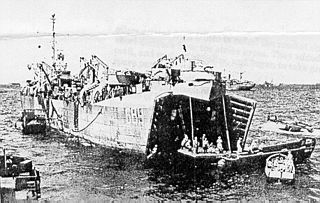
USS LST-689 was an LST-542-class tank landing ship built for the United States Navy during World War II. Late in her career she was renamed Daggett County (LST-689)—after Daggett County, Utah, the only U.S. Naval vessel to bear the name—but never saw active service under that name.

USS Racine (LST-1191) was the thirteenth of twenty Newport-class tank landing ships of the United States Navy (USN) which replaced the traditional bow door-design tank landing ships (LSTs). The second ship named after the city in Wisconsin, the ship was constructed by National Steel and Shipbuilding Company of San Diego, California. The LST was launched in 1970 and was commissioned in 1971. Racine was assigned to the United States west coast and deployed to the western Pacific Ocean during the Vietnam War. The ship was transferred to the Naval Reserve Force in 1981. The LST was decommissioned in 1993 and placed in reserve. Racine was struck from the Naval Vessel Register in 2008 and after an attempted sale to Peru failed, was discarded as a target ship during a sinking exercise in July 2018.

The Miura-class landing ship tank is a class of three tank landing ships (LSTs) that served with the Japanese Maritime Self-Defense Force (JMSDF) from 1975 to 2002. They were primarily deployed for logistic support but were also used to carry heavy construction equipment such as trenchers.
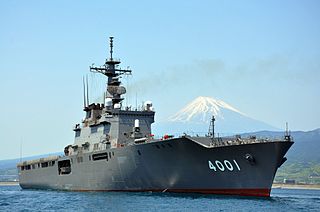
JS Ōsumi (LST-4001) is the lead ship of the Ōsumi-class tank landing ships of the Japan Maritime Self-Defense Force (JMSDF).

JS Kunisaki (LST-4003) is the third ship of the Ōsumi-class tank landing ships of the Japan Maritime Self-Defense Force (JMSDF).
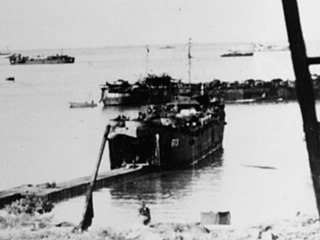
USS LST-613 originally was a United States Navy LST-542-class tank landing ship built during World War II and in commission from 1944 to 1946, and again in the late 1952. In 1976, she was sold to the Republic of Singapore Navy and renamed RSS Persistence (L-205).
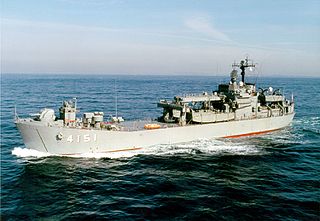
JDS Miura (LST-4151) was the lead ship of the Miura-class landing ship tanks of the Japanese Maritime Self-Defense Force. She was commissioned on 29 January 1975.

JDS Ojika (LST-4152) was the second ship of the Miura-class landing ship tanks of the Japanese Maritime Self-Defense Force. She was commissioned on 22 March 1976.

JDS Satsuma (LST-4153) was the third ship of the Miura-class landing ship tanks of the Japanese Maritime Self-Defense Force. She was commissioned on 17 February 1977.

JS Yaeyama (MSO-301) was the lead ship of the Yaeyama-class minesweepers of the Japanese Maritime Self-Defense Force. She was commissioned on 16 March 1993.
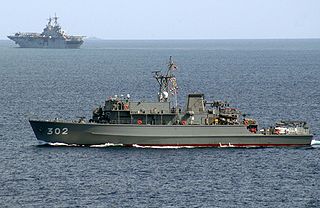
JS Tsushima (MSO-302) was the second ship of the Yaeyama-class minesweepers of the Japanese Maritime Self-Defense Force. She was commissioned on 23 March 1993.

JS Hachijō (MSO-303) was the third ship of the Yaeyama-class minesweepers of the Japanese Maritime Self-Defense Force. She was commissioned on 24 March 1994.
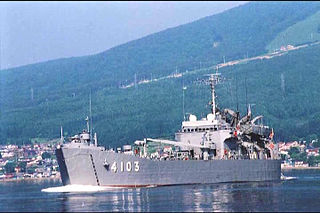
The Atsumi-class landing ship tank is a class of three tank landing ships (LSTs) that served with the Japanese Maritime Self-Defense Force (JMSDF) from 1972 to 2005. They were primarily deployed for logistic support but were also used to carry heavy construction equipment such as trenchers.
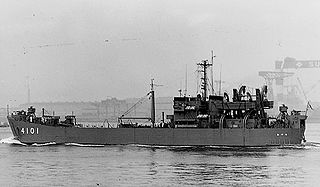
JDS Atsumi (LST-4101) was the lead ship of the Atsumi-class tank landing ships of the Japanese Maritime Self-Defense Force. She was commissioned on 27 November 1972.

JDS Motobu (LST-4102) was the second ship of the Atsumi-class tank landing ships of the Japanese Maritime Self-Defense Force. She was commissioned on 21 December 1973.

JDS Nemuro (LST-4103) was the third ship of the Atsumi-class tank landing ships of the Japanese Maritime Self-Defense Force. She was commissioned on 27 October 1977.

JDS Hayase (MST-462) was a minesweeper for the Japan Maritime Self-Defense Force.

USS LST-578 was a LST-542-class tank landing ship in the United States Navy during World War II. She was transferred to the Republic of China Navy as ROCS Chung Pang (LST-230).
















